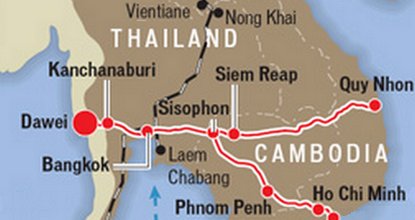
Thailand and Japan have agreed in principle on joint development of a 1.435-metre standard-gauge rail network linking a border village in Kanchanaburi with Cambodia.
Deputy Prime Minister Pridiyathorn Devakula said Tuesday after meeting with Hiroto Izumi, a special adviser to Japanese Prime Minister Shinzo Abe, that Tokyo was willing to invest in the route to connect the Dawei project in Myanmar to Cambodia via Ban Phu Nam Ron in Kanchanaburi, Bangkok, Chachoengsao and Sa Kaeo's Aranyaprathet district.
The route offers another link between eastern and western Thailand.
A working committee of Thais and Japanese will be set up later to work out details such as route, scale and type of investment.
- Prayut off to Japan: Will witness MoI signing Feb 9
- Japan piles on: Investment continues to grow
Prime Minister Prayut Chan-o-cha is scheduled to sign a memorandum of understanding on the rail project during his Feb 8-9 visit to Japan.
A railway from Thailand to Myanmar through Kanchanaburi has only been tried once before, but the project was halted in August, 1945.
Phu Nam Ron is best known these days as a border-crossing town for tourists and visa-runners from Thailand, seeking to visit Myanmar for a short time.
"The route will run at a speed higher than Nong Khai-Bangkok-Map Ta Phut [which will run at 160-180 km/h], as Japan wants to develop a genuine high-speed train with a speed of more than 200 km/h," MR Pridiyathorn said.
Transport Minister Prajin Juntong recently said after a meeting on the Sino-Thai rail development project that Thai and Chinese officials were on the same page regarding construction of an 873-km Nong Khai-Map Ta Phut-Bangkok-Kaeng Khoi route.
Thailand and China agreed the rail route would be 1.435-metre standard gauge divided into four sections: Bangkok-Kaeng Khoi (133 km), Kaeng Khoi-Map Ta Phut (247 km), Kaeng Khoi-Nakhon Ratchasima (139 km) and Nakhon Ratchasima-Nong Khai (355 km).
The Bangkok-Kaeng Khoi and Kaeng Khoi-Map Ta Phut sections will be built under one contract. Construction of those sections is set to begin in September.
The Kaeng Khoi-Nakhon Ratchasima and Nakhon Ratchasima-Nong Khai sections will be constructed under another contract, to begin late this year or early next.
MR Pridiyathorn said Japan was being urged to invest in the Dawei project, a long-awaited joint development between Thailand and Myanmar.
"Japan was invited to become the third partner in Dawei because Dawei is a very large-scale project," he said.
"Dawei's development will see quick progress if Japan agrees to join the development."
Japan is also invited to act as an observer at a joint meeting of Thai officials and their Myanmar counterparts this week.
The two countries are scheduled to sign an agreement on the first phase of Dawei development.
MR Pridiyathorn said the official meeting of the Dawei policy panel would take place tomorrow or Friday and endorse the development projects of Italian-Thai Development Co (ITD) and Rojana Industrial Park Plc.
ITD and Rojana have proposed developing 27 sq km of industrial estates and constructing a two-lane road from the Thai border to Dawei as well as building a port and a power plant.
Dawei, a Myanmar city 350 kilometres west of Bangkok, will feature a number of megaproject investments and a special economic zone (SEZ).
Last October, the Thai and Myanmar governments agreed to revitalise the project by letting Thai firms play a bigger role in the much-delayed SEZ after Gen Prayut paid an official visit to the country.
Arkhom Termpitayapaisith, secretary-general of the National Economic and Social Development Board, previously said the initial phase would take two or three years to complete.
Thailand and Myanmar see completion of projects in the initial phase as a confidence builder for foreign investors.
A motorway connecting Dawei with Laem Chabang port in Chon Buri province is also under consideration.


